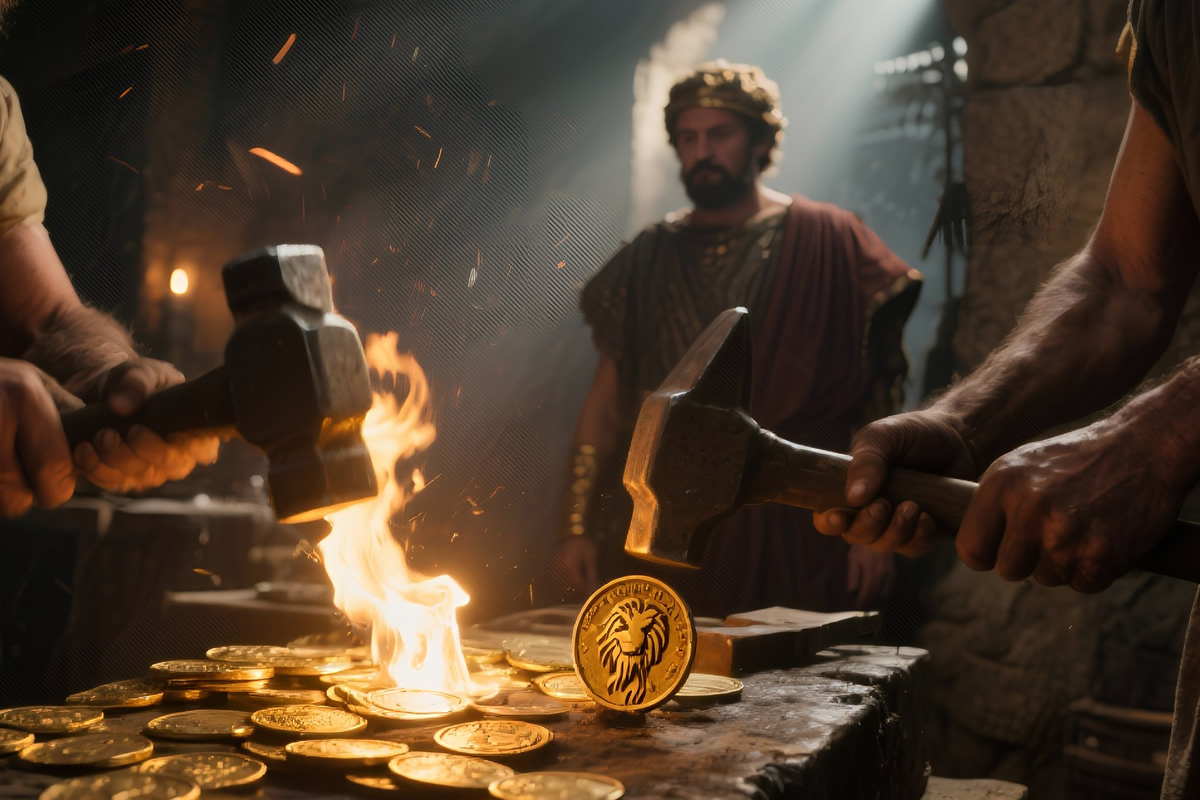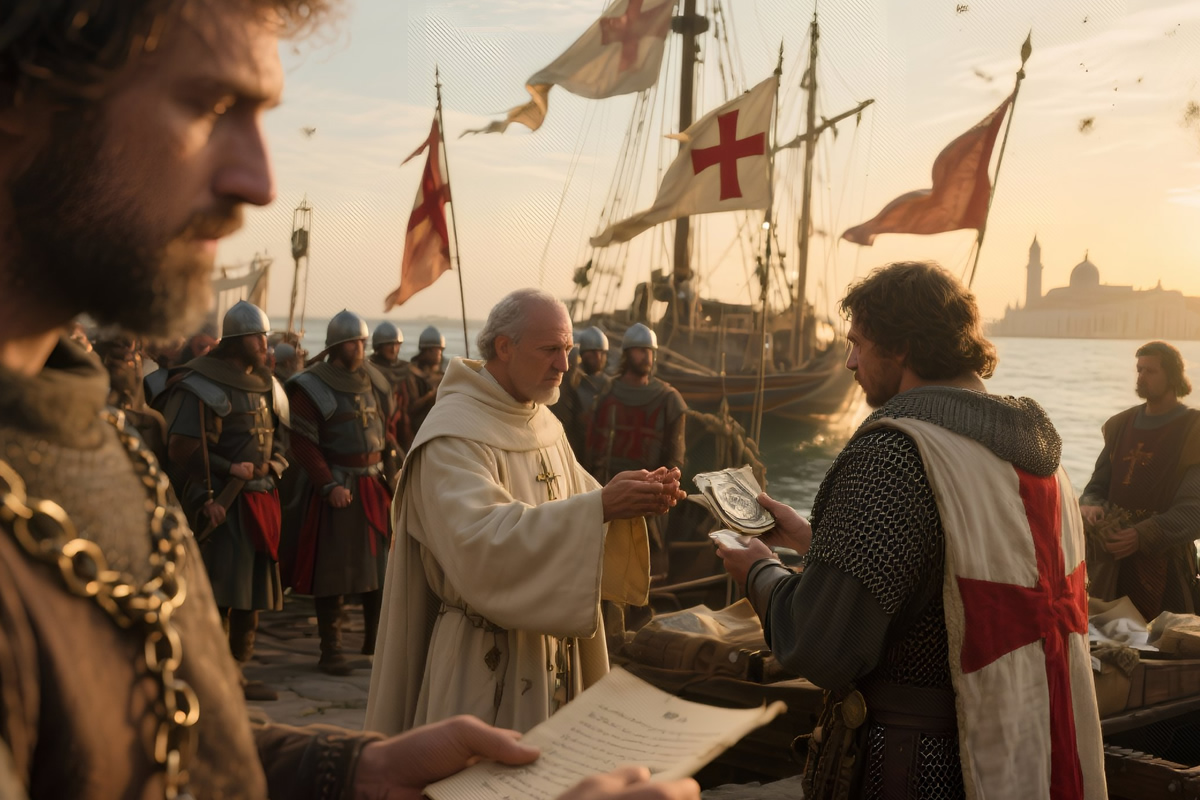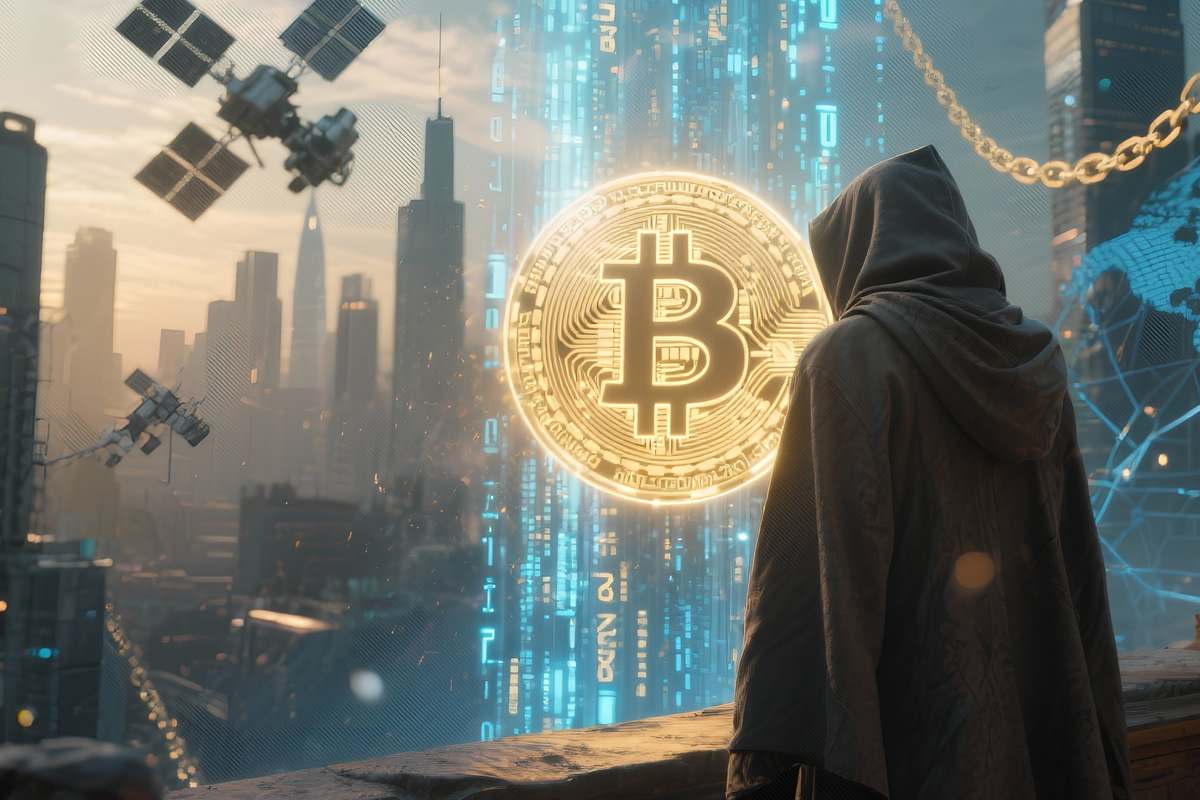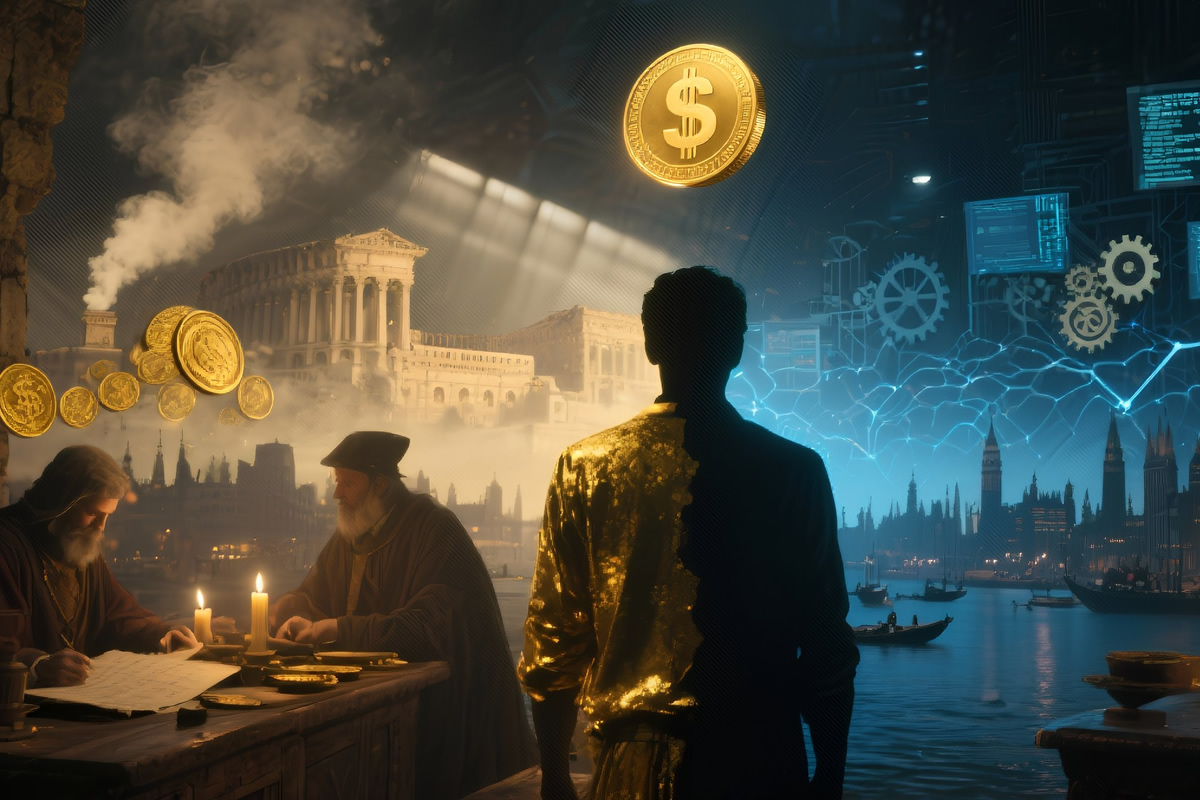In the beginning, there were no coins, no banks, no debts — only need and trust. A hunter traded meat for a farmer’s grain, a potter swapped a vessel for a bolt of cloth. The first economies were built on memory, not numbers. But as tribes grew into cities and cities into empires, memory became unreliable, and trust demanded a symbol. Thus, money was born — not from greed, but from the necessity to measure faith between strangers.
From that simple idea grew the most powerful construct in human history. Money transcended borders, beliefs, and bloodlines. It united merchants across deserts and oceans, funded wars, built temples, and toppled kings. Every civilization that rose to greatness — from Mesopotamia to Rome, from the Abbasid caliphs to the Dutch merchants — forged its destiny through the alchemy of value. Where swords failed, coins conquered.
Unlike armies or religions, money does not demand loyalty through fear or faith; it whispers promises. It tells farmers their labor has worth, tells rulers their power has limits, tells nations they are bound by invisible chains of credit. The rise and fall of every empire has echoed the rhythm of its currency — inflation and collapse, abundance and famine, debt and rebirth. History is not written only in blood or ink, but in ledgers.
For millennia, humanity believed money was something real — a piece of metal, a note backed by gold, a tangible promise. But the deeper truth is unsettling: money has never truly existed outside our collective imagination. Its power depends entirely on belief. When people stop believing, the system dissolves. And yet, like faith itself, it always returns in a new form — stronger, smarter, more abstract.
The story of money is, therefore, the story of control. Those who issue it rule the world quietly. Pharaohs once commanded slaves to build pyramids; central banks command entire populations to work, borrow, and consume. Every generation believes it is free, unaware that its time and energy are minted into digital symbols. The modern worker labors not for kings or gods, but for the algorithms of finance — invisible priests of a secular religion.
Yet money is also a mirror of human progress. It has funded voyages across uncharted seas, inspired cathedrals and space stations, and connected humanity in ways unimaginable to our ancestors. It reveals both our genius and our folly — how the same instrument that built civilization also fuels its corruption.
Today, we stand at another turning point. Paper has become code, gold has become data, and wealth exists as a flicker of light in a global network. The ancient questions return with new urgency: what gives money value? Who decides it’s worth? And what happens when the system that sustains us begins to fail?
This is not merely an economic chronicle. It is a human story — of invention, deception, ambition, and faith. From barter to blockchain, from clay tablets to cryptocurrencies, we will follow the long arc of money’s evolution. It begins with trade and ends, perhaps, with control over the human mind itself. The empire of gold has become the empire of code.
The Age of Barter and Shells

Civilization begins not with kings but with trade. Long before power was codified into law, it was measured in what one could offer and what another would accept. Barter was the first diplomacy—a quiet negotiation between hunger and possession. The shepherd who needed grain had to find the farmer who desired wool. It was a dance of coincidence, inefficient and cruelly dependent on luck. From this constant inconvenience came humanity’s first political discovery: value could be standardized, and trust could be impersonally exchanged.
The earliest societies learned that wealth was not in the object itself but in the recognition it received. Salt, beads, or shells—these were not valuable because they were rare, but because communities agreed they were. That agreement was the first social contract, older than constitutions, sharper than swords. Whoever could define value ruled the transaction; whoever ruled the transaction, ruled men. Thus, money was born not from the market, but from ambition.
The cowrie shell became its first global ambassador. Fragile, decorative, worthless to nature—but priceless to men. From the African coasts to the temples of India, it crossed borders that no army could. It taught humanity a dangerous truth: power could be stored in beauty, and control could travel invisibly in the palm of one’s hand. The chief who controlled the supply of shells did not need to fight; he only needed to withhold.
In every village, the same drama unfolded. People began to measure one another not by strength or courage, but by possession. Trade created inequality faster than conquest. Wealth turned into hierarchy; hierarchy demanded protection; protection demanded tribute. Thus, even before the first coin was struck, the architecture of control was already in place.
Those who understood this principle—priests, chieftains, and cunning traders—saw opportunity. By sanctifying certain objects, they made belief their ally. A shell blessed by the temple could purchase forgiveness; a handful of salt could settle a blood debt. Spirituality and economy merged into one altar. The wise began to grasp that faith was the most profitable commodity of all.
But faith, like every currency, decays when overused. When too many shells flooded the markets, their power evaporated. When everyone possessed wealth, no one truly had it. The early traders discovered that value survives only under discipline—an idea that would later guide emperors, bankers, and every ruler who learned that scarcity is the mother of obedience.
Barter had been a negotiation between equals; currency became a contract between masters and dependents. Once a value was symbolized, it could be manipulated. The moment people agreed that a shell represented food or safety, they surrendered part of their freedom to those who controlled the supply. It was the first form of peaceful domination—a conquest by consent rather than by blood.
So ended the innocent age of trade. The world had discovered something far more potent than weapons: an illusion everyone chose to believe. And though its form would change—into metal, into paper, into numbers on a glowing screen—the essence would remain. Money would never again be just a means of exchange; it would be the art of governing without force.
The Birth of Metal Money

Seventh century before Christ. The kingdom of Lydia, in what is now western Turkey, glitters with ambition. Gold dust from the River Pactolus fills its markets; traders weigh it with trembling hands. But King Alyattes, watching his merchants quarrel over purity and weight, sees chaos disguised as prosperity. He orders his smiths to forge round pieces of electrum—gold and silver alloy—stamped with the royal lion. Each piece bears not just metal, but authority. With one decree, value is standardized, and power begins to wear a face. The first coin has been struck, and the world will never again be the same.
The Lydian coin solved what barter and shells never could: it merged faith with force. No longer did value depend on personal trust; it depended on the seal of the ruler. The coin was both a promise and a threat—its worth guaranteed by the state’s strength, its counterfeit punishable by death. Where the barterer once needed persuasion, the monarch now needed only decree. Gold became obedience in solid form.
Other kingdoms rushed to imitate Lydia’s invention. The Greeks adorned their coins with gods and heroes, Rome with emperors and victory wreaths. Each image told a story: “Our power is eternal, our wealth divine.” Money thus became the state’s most persuasive propaganda, circulating faster than armies, reminding every citizen whose face fed them. A denarius carried Caesar’s portrait into every corner of his empire—a silent army of silver loyal to one master alone.
Metal money transformed trade into empire. Markets expanded beyond borders; wealth could be stored, hidden, or stolen. Armies marched not for faith, but for gold to mint more coins. Conquest became an economic necessity, not a moral crusade. The treasury replaced the temple as civilization’s beating heart, and taxes became the ritual of submission. No priest could match the discipline of a tax collector.
Yet in this new economy, the illusion of fairness persisted. Metal seemed honest—solid, immutable, incorruptible. People trusted it more than they trusted kings. But here lay the cunning of rulers: the coin’s value depended not on its shine but on its purity, and purity was easy to manipulate. Shave a little silver, dilute a little gold, and a sovereign could multiply his fortune overnight while the poor still believed in its weight. Counterfeiting became treason for the weak, policy for the powerful.
Thus began the first inflation—born not from greed below, but from deceit above. Empires learned that the surest way to rule was not through fear, but through slow erosion of trust. When citizens no longer noticed that their coins contained less metal, they were already conquered in spirit. Gold had taught humanity a cruel arithmetic: stability was always temporary, and prosperity always borrowed.
Still, metal money brought order to chaos. It created measurable wealth, transferable debt, and calculable ambition. A merchant in Athens could now negotiate with a trader in Tyre without ever meeting him. The invisible web of trade grew thicker than any wall. Money had become the empire no sword could defend and no rebellion could fully destroy.
By the time Rome inherited the world, coinage was already a weapon of ideology. Each emperor minted his own likeness as proof of divine legitimacy. To touch the coin was to touch the state. And when Rome finally began to mix copper into its silver, the empire’s decline was already engraved on its currency. The coin had turned against its creator.
Metal money had conquered distance, trust, and time—but not corruption. It proved that value could be commanded by authority, but never purified of human vice. The world would soon search for something even lighter, more flexible, more easily controlled than gold: paper.
Gold and Silver Empires

By the time Alexander’s armies marched east and Rome’s legions thundered west, money had already become the empire’s bloodstream. Gold and silver flowed like lifeblood through markets, temples, and palaces. To command it was to rule men without raising a sword. A general could lose a battle and recover, but a bankrupt treasury meant extinction. Every throne in antiquity was nailed together with coins.
Rome perfected this science of domination. The denarius was not merely a medium of exchange; it was a sermon in silver. On one side—the emperor’s face; on the other—divine symbols of victory, justice, or peace. Each coin whispered the same message: loyalty has value, and rebellion is expensive. The Roman state understood what few dared admit—that ideology is fragile, but accounting is eternal. Where legions conquered, mints followed. Every new province was forced to accept imperial currency, thus becoming dependent on the very system that enslaved it.
But metal, like empire, corrodes. The more Rome expanded, the less silver it had to sustain its illusions. Soldiers demanded pay, roads demanded gold, senators demanded bribes. The emperors, cornered between vanity and insolvency, turned to alchemy of deceit. They began to dilute coins with copper, maintaining their shine but hollowing their worth. It was a political masterpiece—appearance preserved, reality debased. When citizens finally realized that their money bought less bread and fewer dreams, it was already too late. Inflation had done what no barbarian could: it devoured Rome from within.
This pattern would repeat through centuries like a curse. Monarchs discovered that debasement was cheaper than reform, that one could print confidence faster than one could earn it. Gold thus became both symbol and sedative. When subjects trembled, rulers opened the vaults and showed them gleaming proof that the realm was safe. It never was.
Meanwhile, across seas and deserts, new empires of metal arose. The caliphs of Baghdad, the sultans of Cairo, the traders of Timbuktu—all measured wealth not by land or bloodline, but by the weight of their gold dinars. The Islamic world, unlike medieval Europe, refused to corrupt its coinage. A dinar from Cordoba could buy silk in China—proof that trust, not territory, defines an economy. The West would later steal this lesson and call it progress.
In Europe’s feudal shadows, kings borrowed from merchants who quietly became more powerful than their lenders. The Venetians and Genoese learned that the control of silver mines mattered less than control of silver flows. They financed crusades, fleets, and even coronations, binding monarchs to contracts they could not break. Thus began the slow inversion of power: rulers became clients, and bankers their discreet masters.
Gold and silver, once sacred, became instruments of speculation. Entire wars were waged not for land but for access to mines—in Spain, Bohemia, and the New World. The lust for precious metal turned exploration into extraction, conquest into commerce. When Potosí’s mountains began vomiting silver into Europe, the world market convulsed. Prices soared, peasants starved, and monarchs fattened on illusions of endless wealth. Civilization learned the oldest economic truth: the more gold one finds, the less it is worth.
By the seventeenth century, money had completed its metamorphosis from sacred metal to political weapon. Empires minted their authority in gold, measured their reach in silver, and paid for glory with debt. Yet all shared the same weakness—they depended on finite earth to sustain infinite ambition. The soil could not keep pace with human greed. Paper, faith, and promises would soon replace metal. And those who controlled belief, not bullion, would inherit the world.
Medieval Chaos and the Rise of the Banker

When Rome fell, its coins fell with it. The empire’s collapse shattered the delicate unity of trade, and Europe sank into a confusion of currencies that mirrored its fractured thrones. Every petty lord minted his own metal—thick, thin, clipped, or counterfeit. A merchant traveling from Paris to Prague carried not money, but a sack of doubts. Value changed with every border; a coin’s worth was measured less by silver than by the reputation of the hand that struck it. Commerce survived, but only by instinct. In this wilderness of distrust, a new breed of men emerged—the money changers.
At first, they seemed harmless: merchants who weighed coins, verified purity, and exchanged one lord’s image for another’s. But beneath their modest trade lay a quiet revolution. They understood what kings did not—that gold was useless if it could not travel, and that credit could travel without gold. They began to keep records, tally debts, and settle accounts with ink instead of metal. The world’s first bankers were born, and Europe’s power began to shift from castles to counting tables.
Venice, Florence, and Genoa became their laboratories. These city-states, too small to conquer by sword, conquered instead through arithmetic. Their merchants invented bills of exchange—letters promising payment at a distance—thus freeing trade from the burden of coins. A man could buy silk in Constantinople using nothing more than a signature in Florence. For the first time, wealth was liberated from weight. The future banker was no longer a keeper of gold but a manipulator of belief.
The Church, predictably, hesitated. Usury was declared a sin, lending for profit an offense against divine law. Yet the same Church needed loans to build cathedrals, fund crusades, and bribe kings. Hypocrisy became theology. The papacy turned to the Italian bankers it publicly condemned, sanctifying the sin whenever it suited God’s treasury. From this marriage of guilt and necessity emerged the Medici—a family of merchants who financed popes, crowned dukes, and eventually ruled Florence itself. They understood Machiavelli’s silent principle: money achieves what armies cannot.
By the thirteenth century, Europe’s rulers were all in debt—to merchants, monasteries, or both. The power of the sword was now mortgaged to the power of the ledger. Kings began to realize that loyalty could be purchased in advance, that soldiers, priests, and nobles all obeyed more faithfully when paid on time. War became a business model; peace became an accounting error. And the banker, invisible and indispensable, became its priest.
Still, this new order was fragile. Debts bred resentment, and resentment bred scapegoats. When the Crusades drained Europe’s treasuries, monarchs turned on their creditors—the Jews, the Templars, the Lombards. They were expelled, tortured, or executed, not for greed but for precision. Their wealth was confiscated, their knowledge quietly inherited by those who condemned them. The art of finance, like all heresies, survived its persecution by changing its language.
By the late Middle Ages, the banker’s table had replaced the feudal throne as the true center of power. A monarch could command armies, but a banker could command kings. And unlike warlords, he needed no battlefield—only a pen and a debtor’s promise. From the shadows of the cathedral and the marketplace, a new empire was forming: the empire of credit.
The age of faith had given birth to an age of calculation. Trust, once a spiritual virtue, became a financial instrument. A number on parchment now outweighed a sword in hand. The world was beginning to grasp the truth that would define all modern history: the mightiest ruler is the one whose debts others cannot afford to call in.
Crusades and the Birth of Credit

The year is 1095. At Clermont, Pope Urban II lifts his arms before the crowd and promises absolution for anyone who takes the cross. Faith becomes a weapon, and war a pilgrimage. But behind the thunder of sermons and swords, another army is quietly mobilizing—the merchants, the financiers, the accountants of salvation. For the first time, Europe learns that holiness has a price tag.
To march to Jerusalem required more than zeal; it required silver. Knights sold their lands, monasteries pawned relics, cities imposed new taxes. What had begun as a spiritual cause soon turned into an economic experiment. The Crusades transformed Europe into a marketplace of redemption. Money changed hands faster than prayers. Bankers financed pilgrimages as if they were trade expeditions, expecting repayment not in blessings but in interest.
Venice and Genoa, those patient predators of the Mediterranean, saw opportunity where others saw glory. They supplied ships, provisions, and weapons—not for faith, but for profit. A knight could now buy his passage to heaven on credit. The city-states became the indispensable intermediaries between the Church’s ambition and the knight’s poverty. Thus, commerce entered the temple, and Christendom’s most sacred wars became the rehearsal for capitalism.
The popes themselves were forced to master arithmetic. They needed to collect donations from across a continent and deliver payment to armies half a world away. The solution was elegant and corrupt at once: the birth of transcontinental finance. Letters of credit—signed by papal agents and honored by distant bankers—allowed the Holy See to move wealth without moving metal. For the first time, belief and debt shared the same parchment.
In the Holy Land, commerce followed conquest. European merchants settled in Antioch, Acre, and Jerusalem, importing not only goods but knowledge: Arabic numerals, double-entry bookkeeping, the art of insurance. They returned to Europe richer in wisdom than in spoils. The East had taught them that the true power of money lies not in gold but in trust—a lesson that would later shape Florence’s bankers and London’s stockbrokers alike.
Yet credit, like faith, demanded discipline. When victories faltered and crusaders defaulted, the debts remained. Families were ruined, monasteries bankrupted, kingdoms forced to sell privileges to stay solvent. The idea of permanent debt—once unthinkable—became normal. Medieval Europe discovered the first modern paradox: that borrowing can sustain a system longer than honesty ever could.
The Templars, warrior monks of extraordinary organization, perfected this duality. They fought by sword and lent by quill. Their network of commanderies across Europe and the Levant became the skeleton of a financial empire. A pilgrim could deposit silver in Paris and withdraw it in Acre with a coded receipt—a primitive checkbook centuries ahead of its time. The Templars were not servants of the Church; they were its creditors. That made them indispensable—and, inevitably, doomed.
When King Philip IV of France found his treasury empty, he discovered that the simplest way to erase debt was to erase the creditor. In 1307, the Templars were arrested, tortured, and executed under charges of heresy. Their wealth was seized, their records burned, their secrets buried under the altars they had once guarded. But ideas cannot be executed. The Templars’ system of credit, secrecy, and transnational power survived in quieter hands—the bankers of Florence and Venice, who had learned from their fall that finance must never again wear armor.
Thus ended the age when faith pretended to command gold. From its ashes rose an age where gold would command faith. The Crusades had failed to conquer Jerusalem, but they had conquered something greater: the mind of Europe. They taught princes to borrow, popes to calculate, and merchants to dream of invisible empires built not by crusades, but by credit.
Paper Revolution: China’s Invention

Eleventh century China, under the Song dynasty — a civilization so vast that metal itself cannot keep pace with its ambition. Markets stretch across thousands of miles, from the tea fields of Fujian to the silk routes of the western deserts. Coins clatter in sacks so heavy they break beasts’ backs. Merchants travel armed not against bandits, but against the weight of their own wealth. In the great city of Chengdu, weary traders bring their bronze cash to money houses that promise something miraculous: a slip of paper in exchange, bearing a seal, a date, and a promise.
That promise is jiaozi — the world’s first paper money. What begins as a merchant’s convenience quickly becomes an imperial experiment. The state, ever watchful, sees in these fragile notes a tool more powerful than armies: control without burden. Metal limits; paper multiplies. The Song government takes over issuance, stamps it with the dragon seal, and commands that it be accepted as legal tender. In one act, value is detached from substance, and the emperor becomes the first central banker in history.
For the first time, wealth can be created by decree. No mines, no ships, no toil—only ink. The bureaucracy perfects the illusion: each note backed by trust, each signature sanctified by fear of disobedience. The empire learns the paradox that will haunt all future economies—confidence can print prosperity, and panic can burn it to ash.
The new money transforms commerce. Trade explodes across China’s provinces. Merchants travel light; armies move faster; taxation becomes precise. A farmer can sell his harvest hundreds of miles away without ever touching metal. The empire hums like a machine, its gears oiled by belief. The scholar-officials celebrate it as proof of civilization’s refinement: metal is barbaric, paper is enlightened. Yet even they sense the danger in its elegance.
When rulers discover that prosperity can be summoned by brushstroke, restraint becomes superstition. The printing presses of the Song begin to run without pause. Notes flood the markets, taxes lag behind, and prices soar. The peasants, who once trusted the emperor’s seal more than heaven’s favor, start to hoard grain instead of paper. Confidence cracks. Inflation spreads faster than armies, and faith—the true foundation of money—collapses in silence.
Later dynasties will repeat the ritual. The Yuan, under Kublai Khan, print even grander paper notes, backed not by silver but by decree: those who refuse them face death. Marco Polo, witnessing it, calls it a miracle, not realizing he is watching the birth of modern finance—and its curse. For every empire that adopts paper learns the same arithmetic: a promise is only as strong as the fear of breaking it.
By the time the innovation reaches the West, it will be stripped of its poetry and armed with laws. Europe will claim it as its own, forgetting that China had already mastered, abused, and paid for it centuries earlier. From Chengdu’s markets to Florence’s banks, the same invisible current flows—belief in the intangible, obedience to the printed word.
Thus, from a fragile sheet of fiber and ink, humanity discovered a new kind of wealth: value unchained from matter, grounded only in faith. Paper money was not just an economic invention; it was a philosophical one. It taught rulers that reality could be written—and taught subjects that obedience could be printed.
Gold, Silver, and the Global Web

The year is 1493. Columbus returns from the west, not with spices or silk, but with rumors of endless metal—gold that glitters in rivers, silver that sleeps in mountains. Within a generation, the European imagination becomes intoxicated. Empires are no longer built on crusades or faith, but on extraction. The conquistadors cross oceans not as explorers but as miners of destiny. Spain, once a provincial kingdom, becomes the beating heart of a metallic empire.
In the high Andes, near a desolate mountain called Potosí, men dig into the earth as if clawing at heaven. Tens of thousands of native laborers, bound by chains or debt, descend each dawn into shafts soaked with mercury and blood. They mine silver for a continent they will never see, a king they will never meet, and a god who never answers. From these depths flows the wealth that will finance cathedrals, armadas, and the illusion of divine monarchy. Every coin stamped with Philip’s face carries the whisper of a dying miner.
But silver, once confined to Europe, finds its destiny elsewhere. Galleons leave the port of Seville loaded with coins, bound for Manila and from there to the ports of China. The Ming dynasty, desperate for silver to stabilize its economy, accepts it eagerly. Europe trades what it steals; Asia provides what it makes. From Spanish mines to Chinese markets, the world becomes a circuit of metal, its pulse measured in tons. For the first time, humanity shares a single economy—a web spun from greed, ingenuity, and necessity.
This global trade reshapes the logic of power. Nations rise not by divine right but by their capacity to control the flow of bullion. Venice and Genoa yield to Amsterdam and London, cities that understand that gold moves faster through credit than through ships. The metal that once ruled kings now serves bankers. The Fuggers of Germany, the Medici of Italy, and the merchants of the Dutch Republic all learn the same principle: to own gold is power, but to lend it is sovereignty.
Spain, blinded by its sudden wealth, mistakes abundance for stability. It floods Europe with silver, inflating prices and eroding its own supremacy. The peasants starve as coins lose meaning, while monarchs drown in debts they can no longer repay. The irony is biblical: the empire that owned the world’s silver runs out of value. Meanwhile, England, pragmatic and patient, turns away from mines toward markets. The foundations of modern capitalism are quietly laid not in the mines of Peru, but in the counting houses of London.
Across oceans, the same drama unfolds in miniature. In Africa, gold is traded for weapons; in the Americas, silver for sugar and slaves. Commerce becomes the polite mask of conquest. Ships sail under the banner of trade but carry chains beneath their decks. The Age of Discovery becomes the Age of Accounting. Every human life is entered as a number in someone else’s ledger.
And yet, beneath this cruelty lies genius. The global web of gold and silver creates a new form of interdependence. For the first time, a famine in China can bankrupt a merchant in Antwerp; a shipwreck in the Caribbean can shake the markets of Venice. Money, once local, has become planetary. Empires can no longer exist in isolation—they must participate, compete, and eventually collapse together.
By the dawn of the seventeenth century, the world stood connected by invisible chains of trade and debt. The bullion that once symbolized divine wealth has become an instrument of perpetual motion: mined by the conquered, spent by the conquerors, counted by the bankers, and coveted by all. Humanity has learned to measure itself in ounces. But metal, though heavy, is finite—and soon the world will seek a new medium that promises infinity: speculation.
The Tulip and the Bubble

Seventeenth-century Holland is the envy of the world. Its fleets command the seas, its warehouses overflow with spices and silk, and its merchants, not its monarchs, decide the fate of nations. Wealth hums through Amsterdam like wind through a thousand sails. Yet amid this triumph of reason and commerce, a new madness takes root—born not of desperation, but of abundance. The object of obsession is a flower.
The tulip, imported from the Ottoman Empire, arrives in Dutch soil as an exotic curiosity, prized by botanists and aristocrats alike. Its colors—deep crimson, golden streaks, and impossible blues—seem to mock restraint itself. Soon it ceases to be a plant and becomes a promise. In the taverns and exchanges of Amsterdam, bulbs are traded like royal jewels, their prices climbing beyond all logic. A rare variety, the Semper Augustus, sells for the price of a canal house. Servants, scholars, and nobles all plunge into the same delirium. The republic that had mastered trade becomes addicted to fantasy.
The mechanics of greed are simple and eternal. First comes admiration, then imitation, then leverage. Contracts are written not for flowers, but for futures—paper promises of bulbs yet to bloom. Debt becomes fertilizer for illusion. Those who missed the first profits borrow to catch the second; those who sense the madness hope to exit just before collapse. Each man believes he will be cleverer than the next, and all share the same delusion: that the market rewards intelligence rather than timing.
The tulip trade becomes the mirror of a nation’s soul. Ministers warn of moral decay, preachers call it vanity, yet even they secretly buy a few bulbs “for the glory of God.” The moralists curse avarice while envying its dividends. Amsterdam’s docks, once the arteries of empire, now serve as stages for rumor. Prices are whispered like prayers; speculation becomes a liturgy of greed. In the coffee houses, men who yesterday sold pepper now trade dreams, arguing over charts and colors as if salvation itself were coded in petals.
Then, as always, comes the reckoning. A single failed auction triggers panic. The chain of promises snaps. Bulbs that yesterday could buy an estate cannot now buy a loaf of bread. Creditors appear at locked doors; courts overflow with lawsuits. The same crowd that once worshipped the flower now curses it as witchcraft. Fortunes vanish overnight, and a nation that believed itself immune to folly discovers it is human after all.
The government intervenes, as governments always do when the rich begin to suffer. Contracts are annulled, debts forgiven, justice suspended for the sake of stability. The losses are absorbed by those too small to protest—the artisans, the laborers, the cautious savers who never speculated at all. Thus ends the first great financial bubble: not with ruin for the bold, but with quiet confiscation from the meek.
Machiavelli would have recognized the pattern. Power does not destroy greed; it domesticates it. The Dutch Republic emerges from the madness chastened, yet stronger. The same instruments that fueled the tulip frenzy—credit, speculation, futures—are refined and institutionalized. The Amsterdam Stock Exchange is born, and with it, modern capitalism. The bubble was not a failure; it was a rehearsal.
In the centuries to come, the world will repeat Holland’s experiment countless times: South Sea schemes, railways, real estate, and cryptocurrencies. Each generation will believe it has tamed fortune, and each will rediscover the same humiliation. Money, like beauty, seduces most when it promises permanence. And humanity, desperate for control, will always mistake price for value and illusion for order.
Thus, from the ashes of flowers rose a new empire—an empire of speculation, where numbers bloom faster than reason, and where every crash fertilizes the next illusion. The age of gold had forged kings; the age of paper would forge gamblers.
The Industrial and Banking Revolutions

Eighteenth-century Europe no longer prays for salvation—it calculates it. Smoke rises over England’s fields as mills replace monasteries, and the new religion is efficiency. Steam, steel, and speculation combine to create a civilization that worships production as previous ages worshipped God. But every revolution requires a currency of faith, and this new faith is called credit. The Industrial Revolution did not begin in factories—it began in ledgers.
Gold and silver, once the lifeblood of empires, cannot keep pace with machines. A factory can produce more value in a month than a mine in a year, yet no vein of metal can match the hunger of industry. Bankers step forward as the new alchemists, transmuting promises into power. The merchant class, once tolerated by kings, becomes indispensable. They finance railways, shipyards, and wars with the same impartial precision. The British pound becomes not merely a coin, but an instrument of empire—its value anchored not in gold, but in the obedience of colonies.
The Bank of England perfects this machinery of control. Founded in 1694 to fund a war, it evolved into the state’s invisible spine. It prints paper notes, guarantees loans, and regulates the pulse of national credit. The monarch still reigns, but the banker rules. As Machiavelli warned, the most stable tyranny is the one that convinces its subjects they are free because their chains bear interest.
Across Europe, the same transformation unfolds. The Rothschilds, those discreet princes of finance, stretch their web of credit from London to Vienna, Paris to Naples. They lend to both sides of wars, ensuring that no matter who wins, the debt remains. Their couriers carry information faster than any army. When Napoleon fell, they knew it hours before governments did. Knowledge becomes currency; secrecy becomes armor. The banker emerges as the modern strategist—a general who commands from silence.
Industry, meanwhile, breeds paradox. The machines liberate laborers from drudgery only to enslave them to wages. The factory replaces the manor, and the worker becomes a numbered cost. Money circulates faster, yet satisfaction disappears. Poverty, once the consequence of laziness, becomes the byproduct of efficiency. The same steam that powers engines also powers inequality. A few men own the machines; all others serve them. Economists will call it “progress,” though it feels remarkably like feudalism made polite.
Paper money multiplies as fast as factories. The nineteenth century becomes a laboratory for economic illusion. Governments print prosperity; banks lend confidence; citizens exchange promises for promises. Crises follow like clockwork—panics in London, crashes in New York, defaults in Paris. Each disaster is met with the same cure: more debt. Humanity learns to confuse recovery with repetition. Yet each collapse refines the system, teaching rulers to manage panic as artfully as profit.
Still, this new order demands moral justification. Philosophers speak of “markets” as if they were natural laws, not human inventions. The invisible hand replaces divine providence; profit becomes virtue. The Church once absolved sins; now it amortizes them. Charity yields to credit, and poverty is redefined as poor creditworthiness. In every ledger hides a theology: redemption through repayment.
By the century’s end, the factory, the bank, and the government had fused into a single organism. Capital circulates like blood; workers feed the machine with their hours; bankers regulate its pulse. Empires no longer expand for glory but for liquidity. Colonies become balance-sheet entries, their people reduced to units of yield. The age of industry has turned economics into strategy and finance into dominion.
Yet beneath this apparent triumph lurks exhaustion. The system grows faster than the society that sustains it. Productivity outpaces purpose; wealth breeds anxiety. Europe, rich beyond imagination, feels poorer in spirit than ever before. The age of iron and credit has built a magnificent cage—and soon, its keepers will discover that the bars are made not of steel, but of gold.
The Gold Standard and Global Order

By the dawn of the nineteenth century, the world had finally found its idol: gold—immortal, incorruptible, and cruelly finite. Every empire, drunk on the illusion of stability, sought to chain its currency to this perfect metal. What began as accounting prudence became dogma. Economists called it the Gold Standard, but it was less an economic system than a religion—faith in the idea that order could be extracted from the ground and weighed.
Britain, pragmatic and predatory, led the creed. In 1821, it declared its pound convertible into gold at a fixed rate. Other nations, eager to borrow British credibility, followed. Gold became the measure of civilization; to deviate was heresy. Diplomats no longer spoke of alliances, but of parities. Wars were fought with rifles, peace was brokered with ounces. The empire on which the sun never set now ruled not by armies, but by balance sheets. London’s bankers became the new popes of global commerce, their vaults the modern cathedrals of faith.
Under this gilded discipline, prosperity appeared eternal. Inflation vanished, credit stabilized, and the pound—backed by metal and myth—flowed across continents like divine currency. Steamships and telegraphs stitched the planet together; insurance, trade, and speculation became the new sacraments. Yet beneath the surface shimmered the same delusion that had doomed every empire before: the belief that stability purchased with rigidity could last.
Gold enslaved nations as gently as opium. To maintain parity, governments sacrificed employment, wages, even sovereignty. When economies faltered, they did not print relief—they tightened the noose. The banker replaced the priest, prescribing austerity in the name of virtue. Machiavelli would have admired the simplicity: convince the ruled that suffering is moral, and they will guard their own chains.
Meanwhile, America—young, brash, and ambitious—joined the cult with pragmatic zeal. Its vast mines in California and Nevada fed the world’s hunger for stability. Europe, bleeding from revolutions and class unrest, needed the illusion of permanence that gold provided. But illusion demands obedience, and obedience breeds fragility. The same system that bound the globe together made it impossible to move without breaking something.
By the late nineteenth century, the gold standard had created not peace, but interdependence—an empire of mirrors where every nation’s wealth reflected another’s debt. A banking panic in Vienna could freeze credit in Bombay; a trade deficit in London could ruin Buenos Aires. The invisible threads of finance had become tighter than any political treaty. The world mistook connection for security.
When the great wars came, the myth shattered. Mobilization required money, not metal. Nations abandoned gold to print survival. Cannons replaced coins; deficits became as holy as victory. After each catastrophe, the same ritual was repeated: inflation, despair, reconstruction, and a nostalgic return to the golden idol that had failed them. Humanity, ever faithful to its delusions, preferred the false comfort of fixed rules to the burden of judgment.
The gold standard, once hailed as civilization’s spine, revealed itself as its cage. It had created global order at the cost of resilience, prosperity at the cost of freedom. Its collapse was inevitable, yet its ghost still haunts every modern currency. Even today, central bankers speak of “stability” the way medieval monks spoke of salvation—hoping that the glitter of an ancient metal can still sanctify the paper in their hands.
The nineteenth century had gilded the world, but beneath that polish, rot spread. The twentieth would tear the gilding off. The faith in metal would give way to faith in paper—and the empire of gold would yield to the empire of debt.
Federal Reserve and Fall of Paper Faith

The year is 1913. In a quiet meeting on Jekyll Island, a handful of bankers and senators draft a document that will alter the balance of power forever. The public believes they are creating stability; the participants know they are creating dependence. Out of that secret congress is born the Federal Reserve—a private consortium disguised as a public guardian. It will claim to protect the people from panic, yet its true purpose is simpler: to ensure that panic always serves those who control credit.
For centuries, kings had borrowed from bankers. Now, the bankers had a government of their own. The United States—founded in rebellion against taxation—had given its monetary sovereignty to a committee of unelected financiers. The press called it modernization; Machiavelli would have called it conquest. From that moment, money in America no longer represented gold—it represented policy. And policy was written in the language of profit.
The First World War followed, financed not by treasure but by paper promises. Nations discovered that printing debt was easier than raising taxes. The more they printed, the more they owed, and the more indispensable central banks became. The alliance between governments and financiers deepened into something symbiotic—each pretending to restrain the other, both addicted to expansion. By the time the guns fell silent, gold had become ceremonial. Credit was the new god.
Germany learned this lesson in agony. Crushed by reparations, stripped of industry, and abandoned by its lenders, it turned to the printing press as its last weapon. By 1923, the mark was so worthless that children played with stacks of notes as toys. A loaf of bread cost a billion; salaries were carried in wheelbarrows. The middle class, the pride of the old empire, evaporated overnight. Poverty radicalized the masses; despair prepared the ground for demagogues. Thus was born the new arithmetic of power: when trust dies, tyranny follows.
The world’s bankers watched and took notes. Hyperinflation had proven that nations could be destroyed not by invasion, but by liquidity. Control the currency, and you control the conscience of a people. The Federal Reserve, untouched and serene, presented itself as salvation. Its model—managed debt, perpetual credit, invisible taxation through inflation—would become the blueprint for every major economy on earth.
Through the 1920s, prosperity returned, but it was artificial—a house built on speculation, not substance. Brokers became prophets, markets became temples, and everyone borrowed against tomorrow. When the crash came in 1929, the illusion shattered again, but the system survived. The beauty of modern finance was that it no longer needed to avoid collapse—it needed only to profit from it.
In less than two decades, the promise of gold-backed security had given way to the architecture of permanent debt. The rulers of money no longer mined the earth; they mined confidence. By the time the Second World War began, nations were already enslaved not by armies, but by their own accounting. The gold standard was dying in silence, replaced by a subtler tyranny—one measured not in ounces, but in trust.
The Age of Fiat and Plastic

The twentieth century opened with a gunshot and ended with a swipe. Between those two gestures, humanity abandoned metal for myth. The world wars shattered the golden idol and replaced it with something far more pliable—paper backed not by treasure, but by decree. What kings once justified by divine right, governments now declare by legal tender. Money ceased to represent value; it became value. The word fiat—Latin for “let it be done”—summed up the new theology of finance: existence by command.
In 1944, in the quiet halls of Bretton Woods, the victors of war redrew the world’s financial map. The U.S. dollar, strong and swollen with wartime gold, was anointed the new universal standard. Every other currency would bow to it, and the dollar itself would bow only to gold—thirty-five dollars for one ounce, no more, no less. It was a clever illusion, a gold standard without the gold, stability without substance. America became the world’s banker, its vault the new Vatican of economics.
For a generation, the illusion held. Europe rebuilt, Japan reindustrialized, and the dollar ruled unchallenged. But prosperity is the most dangerous drug; it erases discipline. The United States spent freely on wars, welfare, and dreams of infinite growth. By 1971, Nixon faced the inevitable: the gold in Fort Knox could no longer cover the paper in circulation. He severed the link. The promise of redemption died quietly, replaced by a new faith—the promise of confidence. From that moment, money was pure abstraction, a symbol floating free of matter.
The change was invisible to most, yet absolute. Governments could now print prosperity, and central banks could conjure “stimulus” with a keystroke. Economists praised it as liberation; moralists whispered of deceit. Machiavelli would have recognized it as both: freedom for rulers, illusion for the ruled. Inflation became the new tax, debt the new tribute, and the citizen the perfect subject—obedient not to law, but to interest rates.
Then came the plastic revolution. In 1950, the Diners Club card appeared—a small rectangle that turned debt into lifestyle. Soon followed American Express, Visa, and MasterCard. Credit ceased to be a privilege of merchants and became the religion of the middle class. The consumer replaced the citizen, and happiness was denominated in monthly installments. The slogan “Buy now, pay later” replaced the Protestant work ethic. The age of plastic taught humanity that debt was not slavery but participation.
Beneath the surface, power consolidated. Each transaction, recorded and categorized, fed a growing empire of data. The anonymity of cash, once the last refuge of freedom, began to vanish. Banks became surveillance institutions disguised as service providers. The convenience was irresistible; the submission, voluntary. People chained themselves with numbers because it felt modern.
Meanwhile, the state and the market—once adversaries—merged. Politicians promised growth; bankers printed it. Elections were won with borrowed money; recessions were cured with larger loans. The system no longer required belief in God or gold—only in continuity. As long as the music played, no one asked who owned the orchestra.
By the 1980s, credit cards gleamed like badges of identity. Wealth no longer resided in vaults but in digits, and morality was rewritten in accounting terms. Bankruptcy became confession; refinancing became redemption. Nations themselves followed suit, living beyond their means, worshipping GDP as medieval peasants worshipped saints. The global economy entered a perpetual motion machine powered by confidence and denial.
Fiat money had completed its evolution: invisible, infinite, and indifferent. It liberated economies from scarcity while binding individuals to perpetual obligation. Plastic gave the illusion of choice, but every purchase was a small pledge of allegiance—to the banks, to the system, to the story that debt was freedom. And when crises came—as they always do—they were no longer collapses of gold or trade, but of belief.
The age of fiat and plastic proved what centuries of empires had hinted: the truest empire is built not on armies or metals, but on consensus. The rulers of this new order needed no thrones, only printing presses—and soon, even those would prove unnecessary. For the next transformation would strip money of paper, of weight, of touch itself. The world was preparing to worship something even less tangible than faith: code.
Digital Money and the Crypto Revolution

The twenty-first century begins not with a new currency, but with a disappearance. Cash fades quietly, replaced by numbers that exist only as light. The global economy, once a theater of vaults, coins, and paper, now lives inside servers humming in anonymous basements. The dollar, euro, and yen still wear their old faces, but their bodies have become digital ghosts. Money no longer jingles—it blinks.
The transformation began innocently: convenience disguised as progress. Online banking replaced tellers; electronic transfers replaced handshakes. Platforms like PayPal, Visa, and Alipay turned transactions into background noise, seamless and unthinking. The smartphone became the modern wallet, a portable confession booth where every desire and debt is recorded. The public, dazzled by speed, mistook invisibility for safety. Governments mistook traceability for control. Both were right—and both were wrong.
Behind the glow of digital screens, the architecture of power hardened. Central banks no longer needed to print anything; with a click, they could conjure or erase entire fortunes. Surveillance became the currency’s shadow. Every purchase, every payment, every hesitation became data—fed into algorithms that predicted needs before they were spoken. Privacy, once the privilege of the rich, became a form of poverty. The rest were transparent by design.
Then, in 2009, amid the ruins of a global financial crisis, an anonymous figure calling himself Satoshi Nakamoto released a manifesto disguised as code. It offered no central authority, no trust in governments, no middlemen. Its scripture was mathematics; its god, the blockchain. Thus was born Bitcoin—the first decentralized currency, minted not by decree but by computation. In its elegant rebellion lay a dangerous idea: that faith could be transferred from institutions to algorithms.
The early adopters were visionaries and fugitives, libertarians and cynics—those who had lost faith in paper promises. They mined digital coins in garages and traded them in secrecy, dismissing the world’s skepticism as short-sighted. And for a moment, they were right. Bitcoin proved that money could exist without borders, censorship, or permission. It was the revenge of mathematics against politics, the ghost of gold reborn in code.
Yet power, like gravity, cannot be escaped—only delayed. Governments that once dismissed cryptocurrencies as toys soon sought to regulate, tax, or replicate them. Central banks began experimenting with their own digital currencies, wrapping decentralization in bureaucratic silk. What had begun as rebellion became prototype. The dream of freedom was repackaged as efficiency. The system, once threatened, learned and adapted. Machiavelli would have nodded: every revolution is safe once it becomes institutional.
Still, something irreversible had occurred. The blockchain shattered the illusion that money must be physical or controlled. For the first time since Lydia’s coins, value existed outside the state’s authority. The implications were vast—and terrifying. A single private network could now move billions in silence, beyond borders, beyond taxation, beyond surveillance. Money had finally achieved what tyrants and mystics had always desired: omnipresence.
As new currencies multiplied—Ethereum, Ripple, countless imitators—the world divided into two realities. In one, digital fiat tightened its grip through regulation and data. In the other, cryptographic anarchy flourished in the dark, trading volatility for freedom. Between them stood the ordinary citizen, reduced to a data point in one system and a gambler in the other. Freedom had never been so abundant—or so precarious.
The age of digital money did not democratize wealth; it dematerialized it. What once passed through hands now passes through clouds. The banknote, once a symbol of promise, is now a relic—souvenir of an era when value could still be touched. Humanity, after millennia of chasing permanence in shells, metal, and paper, has finally created the most abstract money imaginable. Invisible, untraceable, unstable—and, perhaps, inevitable.
From clay tablets to blockchains, from emperors’ seals to encryption keys, the story of money has been the same: the pursuit of faith disguised as arithmetic. The instruments change; the illusion remains. We no longer trust kings or priests, only code. Yet even code is written by men. And men, as history insists, always find a way to turn belief into power.
The Invisible Currency of Control

In the beginning, money was a symbol of trust. In the end, it became a substitute for it. The journey from barter to blockchain was never about progress—it was about control. What began as a tool to measure value has become the measure of obedience itself. Humanity’s oldest invention has quietly evolved into its most perfect chain, linking souls to systems and choices to consequences.
The empire of gold has long since dissolved, but its spirit survives in silicon. Where once treasuries held coins, now servers hold identities. Value no longer resides in what one owns but in what one reveals. Every transaction, every search, every pause before purchase is recorded, priced, and resold. We are no longer customers—we are collateral. The market has ceased to trade goods; it now trades behavior. The final commodity is human predictability.
In this new order, central banks print nothing, yet everything they do shapes the invisible architecture of life. Interest rates decide the tempo of ambition; credit scores define moral worth. The algorithm replaces the priest, translating uncertainty into numbers and declaring them truth. The individual, armed with infinite access, stands freer than ever—and more easily guided than any subject of empire. Control no longer wears a crown; it hides behind convenience.
The dreamers who once sought freedom through technology now find themselves ruled by it. Cryptocurrencies, born as rebellion, have been absorbed by the same machinery they defied. Their ledgers are transparent; their users, traceable; their fortunes, taxable. Freedom was monetized before it matured. Even anonymity, once priceless, now has a subscription fee.
Meanwhile, governments and corporations converge into something older and colder: a single managerial consciousness that monitors without malice and commands without emotion. No need for whips, prisons, or armies—just the subtle tyranny of metrics. Where medieval rulers taxed harvests, modern ones tax attention. The peasant of the future is not the laborer in the field, but the consumer in the network.
Yet history offers one mercy: every system believes itself eternal until the moment it cracks. The same greed that built cathedrals of finance will one day overreach again. Belief will falter, faith will migrate, and the next form of money will rise from the ruins of this one. Perhaps it will be digital, perhaps spiritual—but it will still require the same ancient ingredient: trust.
Machiavelli would remind us that power never disappears; it merely changes shape. What once glittered in temples now hums in circuits. What once enslaved through fear now binds through comfort. The challenge of the next century will not be to earn money, but to remember what it was meant to serve.
For if the story of money teaches anything, it is this: whoever defines value defines reality. And as long as men believe in something—gold, God, or data—there will always be rulers waiting to mint that belief into currency.
Thus ends the chronicle of money’s thousand-year metamorphosis—from matter to myth, from symbol to system. The empire of control, like all empires, believes itself eternal. It will not be. But until it falls, every coin, card, and code will carry the same inscription, written in a language older than power itself:
“In trust we are owned.”



